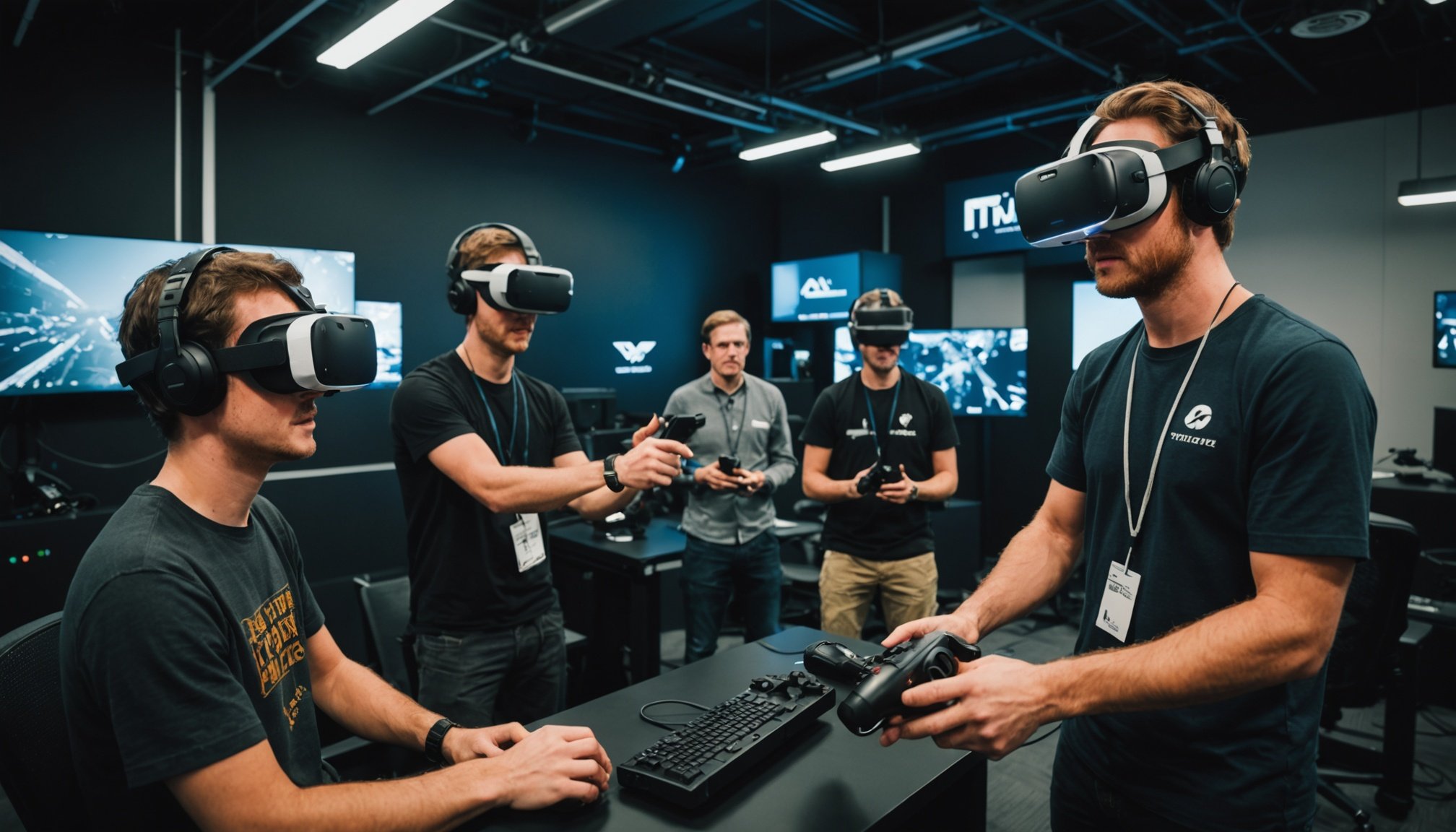Overview of Multiplayer Game Development in Next-Gen VR
The landscape of multiplayer game development in next-gen VR is rapidly evolving, offering exciting possibilities and unique challenges. As the industry progresses, addressing these challenges is crucial to delivering immersive experiences that resonate with players. One major obstacle is network latency, which can significantly affect gameplay immersion and realism.
Advancements in VR technology have paved the way for more connected and engaging multiplayer experiences. Developers are now focusing on improving real-time interactions to enhance player satisfaction and engagement. As a result, ensuring that communication between devices is seamless is of paramount importance.
Topic to read : Unlocking Lifelike Forests: Expert Strategies for Boosting Immersive Woodland Adventure Games
Current trends in multiplayer VR indicate a growing emphasis on social interaction and cooperative gameplay. These trends highlight the importance of a robust networking infrastructure and innovative design solutions to maximize user engagement. By staying ahead of these trends, developers can create multiplayer VR experiences that captivate audiences and set new industry standards.
In conclusion, understanding and adapting to the ever-changing environment of multiplayer VR game development is key to success. By effectively addressing technological and design challenges, developers can usher in a new era of compelling and immersive virtual worlds.
Also to read : Revolutionizing VR Gaming Accessibility: The Power of Eye-Tracking Technology Unleashed
Network Latency Issues
Network latency is a critical factor affecting immersion in VR multiplayer games. High latency can disrupt real-time interactions, leading to a disjointed user experience. In VR, where immersion is key, even minor delays can break the illusion of presence, crucial for maintaining player engagement.
To enhance the multiplayer experience, developers must prioritize reducing latency. This involves optimizing data transmission and reducing the physical distance between players and game servers. One effective strategy is employing edge computing, which processes data closer to the user’s location, minimizing the lag time.
Technical challenges are inherent in maintaining low latency. The VR environment demands rapid processing and response times to uphold the perception of a seamless world. Multiplayer VR games, with their intricate data exchanges, especially suffer from delays more than traditional gaming platforms.
Developers continuously explore innovative network architectures to combat latency. Implementing advanced prediction algorithms can compensate for lags by anticipating user actions and adjusting game states instantly, ensuring synchronization. Additionally, upgrading server infrastructure and leveraging fibre-optic connections can further diminish latency, paving the way for smoother, more immersive virtual experiences.
Cross-Platform Compatibility
As multiplayer game development in next-gen VR advances, ensuring cross-platform compatibility has become a vital goal. With gamers using an increasing variety of devices, enabling interaction across platforms can greatly enhance the player base and user engagement. Despite its benefits, achieving seamless VR compatibility across different platforms poses numerous development challenges.
Developers must navigate a myriad of technical requirements to maintain a consistent gaming experience. Key considerations include aligning graphics processing capabilities, synchronizing gameplay mechanics, and ensuring stability across various VR systems. This necessitates the creation of adaptable frameworks that can integrate disparate technologies.
Successful examples of cross-platform gaming highlight the ingenuity required to merge different systems. Games like “Rec Room” and “No Man’s Sky” demonstrate smooth transitions between platforms, allowing players from PC, console, and VR to interact effortlessly. These titles showcase both the technical requirements and innovative solutions essential to triumph over cross-platform hurdles.
To retain players, addressing these development challenges head-on and fostering a unified play environment remains paramount. As VR technology becomes more ubiquitous, embracing cross-platform compatibility will redefine the horizons of multiplayer gaming.
User Engagement and Retention
In the realm of multiplayer VR games, understanding what drives user engagement is paramount. By creating compelling and adaptive gameplay, developers can foster deeper connections with players, translating to higher player retention rates. A critical factor influencing engagement is the degree to which games offer unique and socially interactive experiences.
Moreover, the dynamics of VR gaming allow for immersion that traditional platforms can’t match. Techniques such as dynamic content updates and personalised player journeys are key to keeping players invested. These methods ensure that experiences remain fresh and engaging, encouraging return gameplay.
There are evident successes in VR gaming strategies. Titles like “Beat Saber” have redefined engagement through seamless difficulty adaptation and rhythm-driven interaction, which illustrate that understanding player preferences and behaviours can substantially boost retention. Additionally, case studies highlight the success of games incorporating feedback loops to adapt and evolve based on player input, ensuring continued relevance in the gaming community. Through innovation and understanding user needs, the potential for engaging and retaining players in the VR space is immense.
Design Complexities in VR
The transition from traditional gaming to VR environments presents unique design challenges. One primary difficulty lies in designing coherent gameplay mechanics within immersive 3D spaces. Unlike 2D games, VR demands intricate balancing between realism and interactivity to foster genuine immersion. Developers must carefully calibrate elements such as physics, interaction models, and spatial design to maintain a seamless player experience.
Creating compelling content involves an understanding of human perception and motion, leveraging innovations like six-degrees-of-freedom (6DoF) for fluid navigation. Embracing innovative design solutions like haptic feedback and dynamic scaling enriches the user’s sense of presence in the virtual world. Additionally, crafting intuitive user interfaces that blend naturally into gameplay is crucial, bypassing traditional control schemes to enhance immersion.
Addressing these complexities requires advanced collaboration between disciplines such as graphics design, engineering, and cognitive science. Staying ahead in this rapidly evolving field means continually adopting new strategies and technologies, ensuring that virtual experiences remain compelling and immersive. By tackling these design challenges effectively, developers can significantly elevate the scope and enjoyment of VR gaming.
Emerging Trends in Multiplayer VR Game Development
In the vibrant realm of multiplayer VR game development, exciting emerging trends are reshaping the landscape. Harnessing cutting-edge technologies, developers are crafting increasingly immersive experiences. Central to these trends is the integration of advanced AI, which enhances gameplay by adapting challenges based on player skill levels, ensuring both engagement and longevity.
The future of gaming is closely tied to sustainable design, with next-gen VR headsets offering reduced power consumption and improved comfort. Meanwhile, virtual economies are becoming more sophisticated, allowing players to engage in complex in-game trade and commerce, further deepening their interactions within virtual worlds.
However, potential future challenges persist. Developers must continue to innovate while addressing VR innovations like haptic feedback and hyper-realistic graphics that demand significant computational resources. Predictions indicate a trajectory towards ever-more immersive and interactive multiplayer experiences, leveraging the power of cloud gaming to offer seamless access regardless of hardware limitations.
As the future of gaming unfolds, these trends underscore a period of transformation in multiplayer VR. Developers who embrace these innovations stand to redefine the gaming industry, setting a new standard for what virtual reality can achieve.










